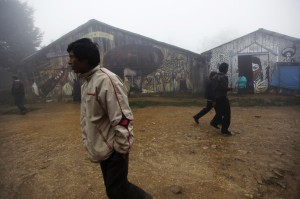By Lomi Kriel
SAN CRISTOBAL DE LAS CASAS, Mexico (Reuters) – The picturesque colonial town high in the mountains in southern Mexico is filled with relics of the rebel Zapatista movement that rocked the region with violence in 1994 and catapulted it to worldwide fame.
Now thousands of tourists and sympathizers come here every year to drink mojitos at a bar called Revolucion, visit nearby Zapatista communities with masked guides, and pick up souvenirs emblazoned with the image of Subcomandante Marcos, who thrilled leftists across the globe and won comparisons with Che Guevara.
Twenty years after Marcos led armed indigenous insurgents in Chiapas state in a “declaration of war” against the government the day Mexico opened its borders to free trade, the Zapatistas have faded from national view and their legacy is in question.
Named for Mexican revolutionary hero Emiliano Zapata, the Zapatista National Liberation Army sparked a 12-day battle with the Army that claimed at least 140 lives, becoming an early symbol for supporters of the anti-globalization movement.
Today Chiapas remains Mexico’s poorest state, and Marcos, the Zapatistas’ masked poet leader, has all but disappeared.
Skilled in courting publicity, the pipe-smoking Marcos has not made any major public appearance since 2006, when he rode across Mexico on horseback to condemn its political class. He banned all media from the 20th anniversary celebrations.
“It’s December 2013. It’s just as cold as it was 20 years ago, and today, like back then, the same flag protects us: that of rebellion,” Marcos wrote in a 3,000-word communique published this week that railed against President Enrique Pena Nieto, his predecessor Felipe Calderon, and the “paid press.”
The Zapatistas brought to prominence the plight of the region’s impoverished Maya Indians, who were once so ostracized that they could not even walk on San Cristobal’s sidewalks.
But while money has flowed in from the government and private donors, many of the Zapatistas’ demands, especially for reform to grant the movement autonomy, have not been met.
In 2001, Congress passed legislation to give the indigenous more rights. But it was not enough for the Zapatistas, who set up their own autonomous justice, health and education systems in five municipalities in Chiapas known as caracoles, or shells.
In a visit granted to Reuters reporters in the Zapatista community of Oventic, the atmosphere was cheerful.
The gates were decorated with flowered wreaths, music played as footage of the Mexican army’s strike showed on televisions, and stalls sold revolutionary T-shirts and Zapatista figurines.
Murals honored the movement’s namesake and spelled out slogans like “Slow, but we’re advancing.” But every request to interview or photograph Zapatistas was denied by a community spokesman, who later forced the reporters to leave.
By contrast, hundreds of camera-toting fans were allowed in: coach buses crammed the narrow, mountainous road to Oventic, bringing visitors from as far away as France and Italy eager to participate in the Zapatista experience and buy trinkets.
ECONOMIC LIBERALISM
Neil Harvey, a New Mexico State University professor and author of “The Chiapas Rebellion,” estimates about 150,000 people live in the Zapatista communities, where indigenous leaders have raised living standards, including outlawing alcohol, improving women’s rights and creating Maya language schools.
“There is this existence of two authorities in Chiapas,” Harvey said. “Legally, it’s still not recognized by the Mexican government, but politically it’s tolerated.”
Still, more than three-quarters of Chiapas, which has one of Mexico’s largest indigenous populations, lives in poverty.
That compares with about half the Mexican population, which is little changed from when then-President Carlos Salinas signed up to the North American Free Trade Agreement (NAFTA) that came into force the day of the rebellion on January 1, 1994.
NAFTA was a major challenge to the Maya because it gave private investors the chance to buy land formerly in communal hands, and the Zapatistas declared it a “death sentence.”
But the economy has continued to open up ever since.
Last month Pena Nieto got a bill passed end Mexico’s 75-year-old oil and gas monopoly, in a move some analysts hailed as the biggest reform of the Mexican economy since NAFTA.
Marcos rejects claims the Zapatistas have failed, saying in his communique that interest in the group proves its relevance.
There is no doubting the fervor of supporters.
“The Zapatistas changed my life and opened my eyes politically,” said Marco Velazquez, 36, a history professor from Mexico City attending the annual celebration. “They’ve managed to do what the government said they couldn’t.”
And they can still muster large gatherings. To mark last year’s anniversary of the uprising, thousands of masked Zapatistas marched in silence across Chiapas.
Those close to the Zapatistas say the movement is as strong as ever, but has deliberately turned away from the limelight.
“They’ve turned inwards and they’re doing their own thing because they realized they weren’t going to get anywhere with the national system,” said Harry Cleaver, a retired economics professor at the University of Texas in Austin.
(Editing by Dave Graham and Lisa Shumaker)














Follow Us